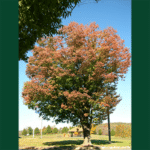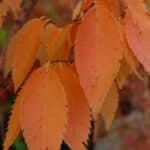Japanese Zelkova
Zelkova serrata
‘Village Green’
Japanese Zelkova

- Cold Hardiness: Zone 5-8
- Size: 50-70' tall
- Light Requirement: Full Sun
- Flowering Time: n/a
- Kentucky Native: No
This 40′-60′ tall shade tree creates a strong, vase-shaped specimen with deep green summer foliage and brick red fall color. It is a widely adaptable and long lived tree for use as a lawn specimen or street tree.
Other info: Introduced by Princeton Nurseries and patented in 1964 (pp2337) for vigorous growth, straight trunk and red fall color. Cold hardiness zone 5-8.
2023 TKPA Winner
More information
Japanese Zelkova is a highly adaptable shade tree native to Japan, Korea and eastern China. It typically forms an upright, vase shaped crown to 60-80’ tall with deep green summer leaves and variable fall foliage color ranging from yellow to bronze and occasionally a brick or rusty red. Small green spring flowers are insignificant.
Zelkova is a highly adaptable species, able to perform well in challenging urban conditions including compacted soil, air pollution and poor soil drainage. It is a member of the Elm family but typically exhibits high resistance to Dutch elm disease. Due to its vase shaped crown, Zelkova is often thought of as a good replacement for the American elm (Ulmus americana.)
Possibly the first named cultivar of Zelkova serrata to be patented (PP02,337) in the United States, ‘Village Green’ was selected, named and patented by William Flemmer III of Princeton (NJ) Nurseries in the 1960s. It was selected out of a batch of open pollinated seedlings grown from one of Mr. Flemmer’s trees that originated from a batch of seed he originally obtained from the Korean Institute of Forest Genetics.
‘Village Green’ was selected for its unusually rapid growth, straight trunk, upright arching growth habit, rusty red fall foliage color and resistance to leaf chewing by both elm leaf beetle and Japanese beetle. It tends to grow wider than ‘Green Vase’ and despite its tight and narrow branch angles, tends to hold up quite well as trees age.



